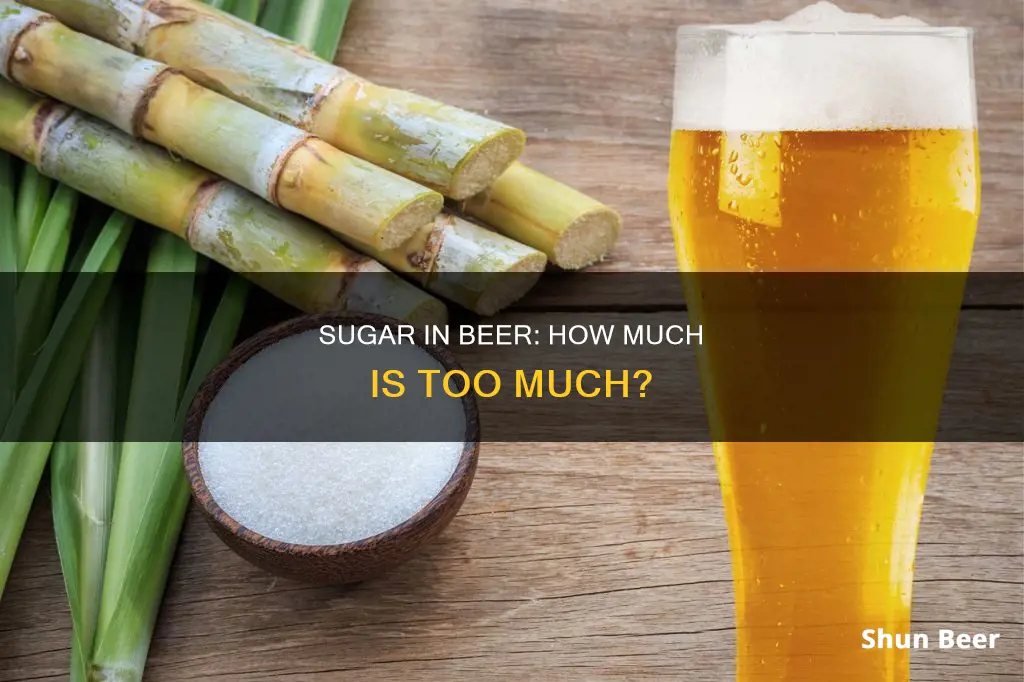
Beer is a popular alcoholic beverage, often enjoyed as a tipple by many. However, it is also a drink that contains varying levels of sugar, which can be a concern for health-conscious drinkers. The sugar content in beer depends on the type and brand, with some beers having higher sugar content due to added ingredients like honey or corn syrup. So, how much sugar is in beer, and what impact does it have on our health?
Sugar Level in Beer
| Characteristics | Values |
|---|---|
| Sugar content in beer | Beer generally has very low sugar content. However, the sugar content depends on the type of beer. Non-alcoholic beers have the highest sugar content, while light beers have slightly more sugar than regular beers. |
| Factors affecting sugar content | Beer gravity (density of the wort), type of yeast, and additional flavours. |
| Carbohydrates in beer | Beer is higher in carbohydrates than wine or liquor. The carb content varies depending on the type of beer. Light beers have fewer carbs, while hoppy craft beers like IPAs and stouts have more carbs. |
| Beer and blood sugar | Beer can lower blood sugar levels as it prevents the liver from producing glucose. It can lead to hypoglycaemia or low blood sugar levels. |
| Beer and diabetes | Beer can be risky for diabetics as it contains sugar and carbohydrates, which can cause fluctuations in blood sugar levels. Diabetics should limit their beer intake and drink it with a low-carbohydrate snack. |
| Alcohol content in beer | The alcohol content of beer varies by type but is typically around 5%. However, craft beers can have an alcohol content higher than 5%. |
What You'll Learn

Beer's sugar content is created by beer gravity
The mashing process involves roasting, milling, and soaking pre-germinated grains in hot water. The grains used are typically barley, but sometimes wheat. The result of mashing is a sugar-containing liquid called wort. During the boiling step, hops or other spices are added.
Once yeast is introduced into the batch, the sugar content generally decreases while the alcohol content goes up. This is because the yeast ferments the wort, converting sugars into alcohol and carbon dioxide. As the yeast ferments the wort, its sugar content decreases, its alcohol content increases, and its gravity lowers.
Therefore, the final sugar content of a beer is based on several factors, including its gravity, the type of yeast, and any additional flavours that might be included, such as honey or corn syrup.
Beers with a high initial gravity will have a high sugar content, but this will be reduced during fermentation. The final sugar content of a beer will also depend on the efficiency of the yeast in fermenting the sugars.
Goldberg Beer: Sugar Content and Nutritional Facts
You may want to see also

Non-alcoholic beer has the highest sugar content
Beer is generally made from yeast, grains, spices, and water. While sugar is not added to the list of ingredients, it is naturally produced when the grains are processed and fermented by yeast. The sugar content of beer depends on several factors, including its gravity, the type of yeast used, and any additional flavours included, such as honey or corn syrup.
The sugar content of beer is not required to be disclosed by law, making it challenging to determine the exact amount of sugar present. However, non-alcoholic beer typically contains significantly more sugar than other types of beer. For example, a 12-ounce serving of non-alcoholic beer can contain up to 28.5 grams of carbohydrates and sugar. In contrast, regular beer typically contains 12.8 grams of carbohydrates and no sugar, while light beer contains 5.9 grams of carbohydrates and only 0.3 grams of sugar.
The high sugar content in non-alcoholic beer can be attributed to the fact that none of the sugar in the wort is converted into alcohol during the fermentation process. As a result, non-alcoholic beer retains a much higher sugar content compared to other types of beer.
It is worth noting that while the sugar content of beer may be relatively low, regular beers are still a source of carbohydrates, which can impact blood sugar levels. Additionally, the alcohol content of beer can also affect blood sugar levels by interfering with the liver's ability to produce glucose. Therefore, it is recommended that individuals with diabetes or blood sugar concerns monitor their blood sugar levels when consuming beer, especially non-alcoholic varieties, to avoid potential health risks associated with blood sugar fluctuations.
The Magic of Soft Candi Sugar in Beer Brewing
You may want to see also

Light beers have more sugar than regular beers
Beer is generally made from yeast, grains, spices, and water. Sugar is not usually listed as an ingredient, but it is created naturally when the grains are processed and fermented by yeast. This process is known as beer gravity, which refers to the density of the liquid (wort) extracted from the mashing process during brewing. When the wort has a lot of sugar, it is called a high-gravity wort.
Once yeast is added to the wort, the sugar content decreases while the alcohol content increases. After fermentation, beer typically consists of 80% fermentable sugars and 20% oligosaccharides, a type of carbohydrate. The final sugar content depends on several factors, including the beer's gravity, the type of yeast used, and any additional flavours included, such as honey or corn syrup.
The sugar content of beer is generally very low, and labelling laws do not require manufacturers to disclose this information. However, light beers tend to have slightly more sugar than regular beers. This is due to differences in the fermentation process, as light beers are brewed using a low-sugar extract made from grain, resulting in less alcohol production.
For example, a 12-ounce serving of regular beer typically contains around 12.8 grams of carbohydrates and no sugar, while a light beer of the same serving size has 5.9 grams of carbohydrates and 0.3 grams of sugar. Non-alcoholic beers have the highest sugar content, as none of the sugar is converted into alcohol during fermentation.
Best Sweet Beer Options: High-Sugar Content Choices
You may want to see also

Beer raises blood sugar levels
Beer is generally made from yeast, grains, spices, and water. Although sugar is not listed as an ingredient, it is created naturally when the grains are processed and fermented by yeast. This process is called beer gravity, and it refers to the density of the liquid (wort) extracted from the mashing process during brewing. When the wort has a lot of sugar, it is called a high-gravity wort.
Once yeast is introduced, the sugar content decreases, and the alcohol content increases. After fermentation, beer typically comprises 80% fermentable sugars and 20% oligosaccharides, a type of carbohydrate. Beer's final sugar content depends on its gravity, the type of yeast, and any additional flavours, such as honey or corn syrup.
Beer contains carbohydrates, which can raise your blood sugar levels. A can of beer contains approximately 15 grams of carbohydrates, and four cans come to about 60 grams. Beer's alcohol content can also confuse the liver and prevent it from producing glucose, leading to hypoglycaemia or low blood sugar.
People with diabetes need to be cautious when drinking beer, as alcohol may contain a lot of carbohydrates, which can cause dangerous fluctuations in their sugar levels. The higher the amount of carbohydrates in alcohol, the greater the risk of developing high blood sugar. Alcohol can also interfere with the effectiveness of hypoglycaemic medications.
To prevent hypoglycaemia, it is recommended not to drink on an empty stomach. Instead, have a low-carbohydrate snack with your beer. It is also important to drink slowly and stay hydrated with water.
For people with diabetes, it is advisable to limit beer intake to the bare minimum. When drinking beer, choose low-calorie or mild beer, and avoid mixing it with sugar-rich colas.
Priming Sugar for Beer: 5-Gallon Secrets
You may want to see also

Beer is high in carbohydrates
Beer is generally made from yeast, grains, spices, and water. While sugar is not listed as an ingredient, it is created naturally when the grains are processed and fermented by yeast. This process is called beer gravity, which refers to the density of the liquid (wort) extracted from the mashing process during brewing. When the wort has a lot of sugar, it is called a high gravity wort.
Once yeast is introduced, the sugar content decreases while the alcohol content increases. After fermentation, beer typically consists of 80% fermentable sugars and 20% oligosaccharides, a type of carbohydrate. Beer's final sugar content depends on its gravity, the type of yeast used, and any additional flavours included, such as honey or corn syrup.
Beer is typically higher in carbohydrates than other alcoholic drinks like wine or spirits. The carbohydrate content of beers varies depending on the type. "Light" beers have the fewest carbohydrates, usually five grams or fewer per serving. They also tend to have a lower alcohol content. Hoppy craft beers like IPAs and stouts tend to be much higher in carbohydrates, typically containing 15 grams or more per serving. They also tend to have higher calorie and alcohol content, so it is best to limit yourself to one serving.
Regular beers tend to be sugar-free, and light beers contain barely one gram per can. However, non-alcoholic beers have the highest sugar content of all. A pint of beer or a glass of wine may seem harmless, but it is important to remember that alcohol may contain a lot of carbohydrates, which can be risky for people with diabetes or those trying to lose weight. Beer raises blood sugar levels as it contains sugar in the form of maltose or maltodextrin.
Beer or Cider: Which Has Less Sugar?
You may want to see also
Frequently asked questions
Yes, beer does contain sugar, but the amount varies depending on the type of beer and the ingredients used. The sugar in beer is created naturally when grains are processed and fermented by yeast.
The exact amount of sugar in beer can be difficult to pinpoint as it is not required by law to be labelled. However, according to Healthline, a 12-ounce serving of regular beer typically contains 12.8 grams of carbohydrates and no sugar, while light beer contains 5.9 grams of carbohydrates and 0.3 grams of sugar. Non-alcoholic beer has the highest sugar content, with 28.5 grams of carbohydrates and sugar.
The final sugar content of beer depends on several factors, including its gravity, the type of yeast used, and any additional flavours added, such as honey or corn syrup.
Yes, beer can affect blood sugar levels, especially in people with diabetes. Beer contains sugar in the form of maltose or maltodextrin, which can raise blood sugar levels. Additionally, alcohol interferes with the liver's ability to produce glucose, which can lead to hypoglycaemia or low blood sugar levels.
People with diabetes do not need to completely avoid alcohol, but it is important to drink in moderation. It is recommended to limit consumption to no more than one drink per day for women and up to two drinks per day for men. It is also advised to avoid drinking on an empty stomach, to have a low-carbohydrate snack with beer, and to monitor blood sugar levels regularly.







